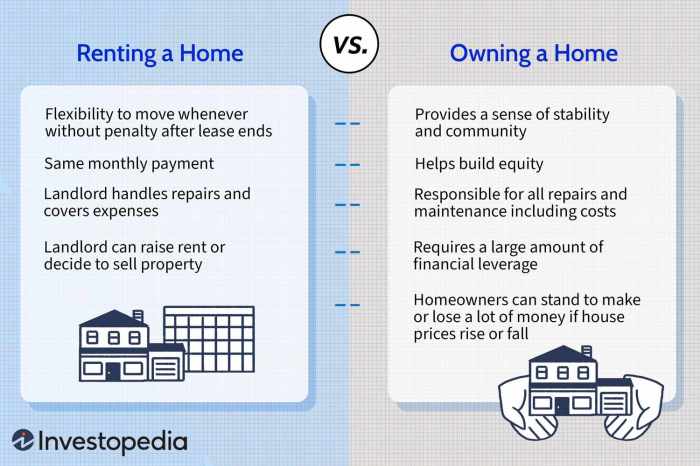Renting House Steps A Comprehensive Guide
Renting a House: A Step-by-Step Guide
Renting house steps – Finding the right rental house can be a significant undertaking, but with careful planning and a methodical approach, the process can be streamlined and significantly less stressful. This guide provides a comprehensive overview of the key steps involved in renting a house, from defining your needs to moving out.
Defining Your Needs and Budget
Before embarking on your house hunt, it’s crucial to establish clear criteria and a realistic budget. This initial phase lays the groundwork for a successful rental experience.
- Ideal Location: Consider proximity to work, schools (if applicable), public transportation, shopping centers, and recreational facilities. Weigh the importance of a short commute against access to amenities and desired neighborhood characteristics. For example, a shorter commute might mean living further from parks and entertainment options.
- Rental Budget: Determine a realistic budget by assessing your monthly income and expenses. A general rule of thumb is to allocate no more than 30% of your gross monthly income to rent. Carefully analyze your financial situation, including debt payments, savings goals, and other recurring costs, to arrive at a comfortable and sustainable rental budget. Consider using online budgeting tools to assist in this process.
- Must-Have and Desirable Features: Create a prioritized list of essential features (e.g., number of bedrooms and bathrooms, parking, pet-friendliness) and desirable features (e.g., a yard, updated appliances, central air conditioning). This list will guide your property search and help you evaluate potential rental houses effectively. Prioritize based on your needs and budget constraints.
Searching for Rental Properties

Source: investopedia.com
Numerous resources are available to assist in your rental property search. Understanding the strengths and weaknesses of different platforms and strategies is key to efficiency.
- Online Rental Platforms: Popular platforms like Zillow, Trulia, Apartments.com, and Realtor.com offer extensive listings, search filters, and user reviews. Compare their features, such as map views, photo quality, and detailed property information, to determine which platform best suits your needs. Some platforms may specialize in specific property types or geographic areas.
- Effective Search Strategies: Use specific s and filters (e.g., number of bedrooms, price range, pet-friendliness) to narrow your search results. Save your favorite listings and regularly check for new properties that match your criteria. Consider expanding your search radius slightly to broaden your options, but be mindful of your commute.
- Real Estate Agent Services: Real estate agents can provide valuable assistance in your rental search. They have access to a wider range of properties, including those not publicly listed, and can handle much of the communication and paperwork. However, be aware that their services may come with fees or commissions.
Viewing Properties and Application Process
Visiting potential rental properties and completing the application process requires careful preparation and attention to detail.
- Viewing Checklist: Bring a checklist to each viewing, including items like a notepad, measuring tape, camera, and a list of questions for the landlord or property manager. Take photos and notes on the property’s condition, noting any repairs or maintenance issues. Check the functionality of appliances and plumbing.
- Rental Application: Rental applications typically require personal information, employment history, rental history, and references. Ensure all information is accurate and complete. Gather necessary documents such as pay stubs, bank statements, and letters of recommendation in advance.
- Application Types and Requirements:
| Application Type | Required Documents | Processing Time | Fees |
|---|---|---|---|
| Online Application | Personal information, employment history, rental history, references, digital copies of documents | 1-7 days | Varies, may be included in application fee |
| Paper Application | Personal information, employment history, rental history, references, physical copies of documents | 1-2 weeks | Varies |
| Agent-Assisted Application | Personal information, employment history, rental history, references, documents as required by agent | 1-2 weeks | May include agent fees |
| Direct Landlord Application | Personal information, employment history, rental history, references, documents as required by landlord | 1-2 weeks | Varies |
Understanding Lease Agreements, Renting house steps
The lease agreement is a legally binding contract outlining the terms of your tenancy. Thorough review and understanding are paramount.
- Key Clauses and Terms: Pay close attention to clauses related to rent amount and payment schedule, lease duration, pet policies, maintenance responsibilities, and termination procedures. Understand the implications of each clause and ensure they align with your expectations.
- Review and Negotiation: Carefully review the lease agreement before signing. Don’t hesitate to negotiate terms that are unclear or unfavorable. If you have questions or concerns, consult with a legal professional or trusted advisor.
- Common Misunderstandings: Be aware of common misunderstandings regarding late fees, lease renewals, and tenant responsibilities for repairs. Clarify any ambiguities with the landlord before signing the agreement.
Moving In and Settling In

Source: myflippingjourney.com
The move-in process involves several crucial steps to ensure a smooth transition and protect your interests.
- Moving Checklist: Prepare a detailed checklist encompassing tasks before, during, and after the move. This includes arranging movers, packing essentials, changing your address, and notifying utilities of your move. Consider creating a timeline to manage the process effectively.
- Move-In Inspection: Conduct a thorough move-in inspection with the landlord or property manager to document the condition of the property. Note any existing damages, repairs, or maintenance issues. Take photos and have both parties sign the inspection report.
- Establishing Utilities: Contact utility companies to establish service at your new rental property. Schedule installation or transfer of services well in advance of your move-in date. This includes electricity, gas, water, internet, and cable.
Maintaining Your Rental Property
Regular maintenance is essential to preserving the property’s condition and preventing costly repairs. Establishing a proactive maintenance schedule is crucial.
- Maintenance Schedule: Create a schedule for regular upkeep tasks, such as cleaning gutters, changing air filters, and inspecting appliances. Regular maintenance can prevent minor issues from escalating into major problems.
- Common Household Maintenance: Familiarize yourself with basic household maintenance tasks, such as unclogging drains, fixing leaky faucets, and addressing minor plumbing issues. For more complex repairs, contact a qualified professional.
- Reporting Issues: Document all communication with your landlord regarding maintenance issues. Keep records of dates, times, and the nature of the issue, along with any resolutions or follow-up actions. Use a combination of written communication and photos for thorough documentation.
Moving Out Process
The move-out process requires careful planning and attention to detail to ensure a smooth transition and avoid disputes with the landlord.
- Providing Notice: Provide your landlord with the required notice period before vacating the property, as stipulated in your lease agreement. This typically involves submitting a formal written notice.
- Move-Out Checklist: Create a checklist of tasks to complete before moving out, including cleaning the property, making necessary repairs, and removing all personal belongings. Follow the terms of your lease agreement regarding cleaning and repairs.
- Move-Out Inspection: Schedule a move-out inspection with your landlord to document the condition of the property. Compare the condition to the move-in inspection report to resolve any discrepancies. Ensure that both parties sign the move-out inspection report.
FAQ Summary: Renting House Steps
What credit score is typically required to rent a house?
Landlords have varying requirements, but a credit score of 650 or higher is generally preferred. However, co-signers or higher security deposits may compensate for lower scores.
What if I find damage in the property after moving in?
Thoroughly document any pre-existing damage with photos and a written report during the move-in inspection. Report any new damage to your landlord immediately.
How much notice is typically required to break a lease?
Renting a house involves several key steps, from initial searching to signing the lease. Finding the right property is crucial, and if you’re considering Los Angeles, you might want to check out this resource for available properties: los angeles houses for rent. After securing a property, remember to carefully review the lease agreement and understand your responsibilities as a tenant before proceeding to move-in.
Lease agreements specify the required notice period, typically ranging from 30 to 60 days. Early termination may result in penalties, so carefully review your lease.
Can I negotiate the terms of a lease agreement?
While some terms are non-negotiable, others, such as pet fees or painting allowances, are often open to discussion. Prepare your requests and present them professionally.




















